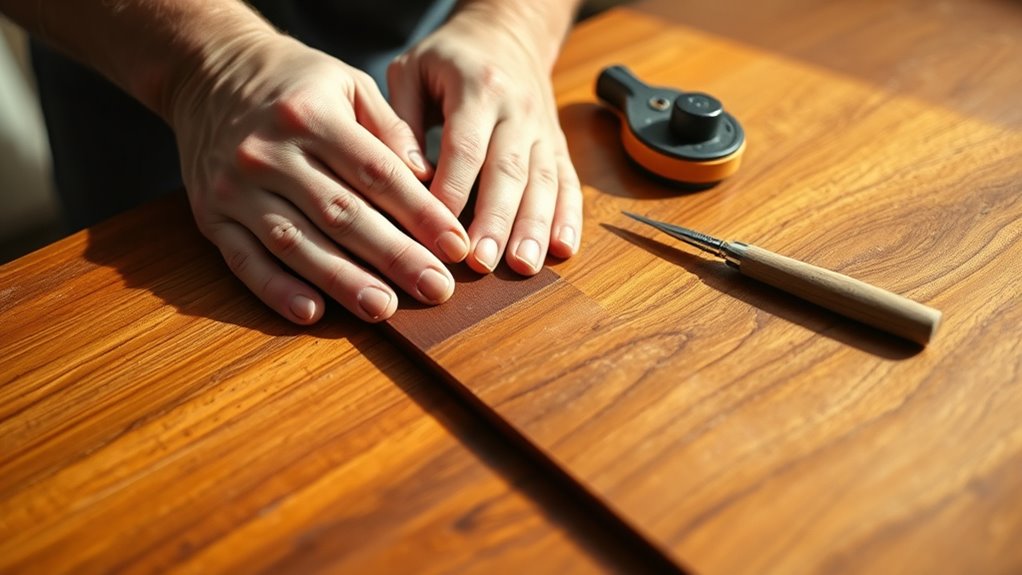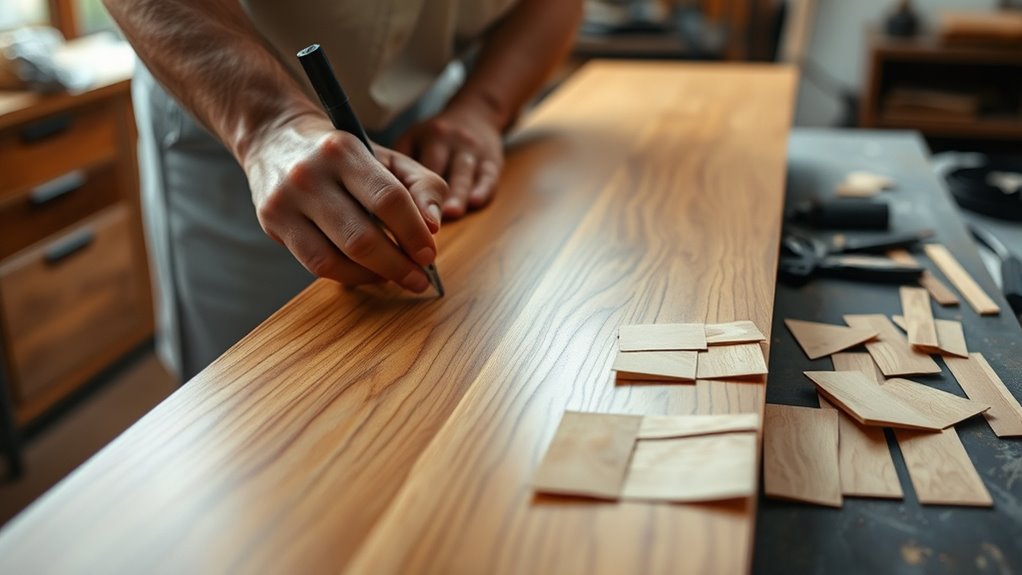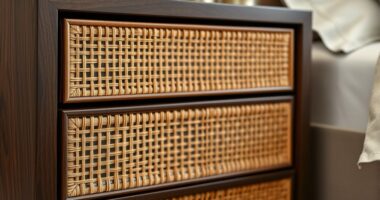When restoring mid-century furniture with veneer damage, choose between patching, inlay, or re-veneering based on the extent of the damage and your desired look. For small chips, you can patch with matching veneer or filler. For moderate issues, inlay offers a seamless fix, while extensive damage often calls for re-veneering the entire surface. Proper matching and technique are key for a seamless finish—continue further to learn how to execute each step effectively.
Key Takeaways
- Assess damage severity to determine whether patching, inlay, or re-veneering is appropriate.
- Small chips and scratches typically require patching with matching veneer.
- Moderate damage may benefit from precise inlay work for seamless repair.
- Extensive or severe veneer loss often necessitates re-veneering for a uniform look.
- Consider aesthetic goals and furniture value when choosing the repair method.

If your mid-century furniture shows signs of veneer damage or wear, replacing the veneer can restore its original beauty and value. Whether the veneer issues are minor scratches, chips, or extensive peeling, proper repair is essential to preserve the piece’s integrity. When considering veneer replacement, you need to decide between patching, inlay, or re-veneering. Each method has its advantages, but your choice depends on the extent of damage and your aesthetic goals.
For small chips or localized damage, wood repair combined with veneer matching is often the best approach. You’ll want to carefully remove the damaged veneer without harming the underlying wood. Once the area is prepped, you can fill any holes or cracks with a suitable wood filler. After the filler dries, sand it smooth to guarantee a seamless surface. When selecting a new veneer, matching the grain, color, and finish is vital for a natural look. Veneer matching involves comparing samples under different lighting conditions to ensure consistency. This step guarantees that the repair blends seamlessly with the existing veneer, making the fix nearly invisible.
If the damage is more extensive but confined to a small section, inlay work can be a beautiful solution. Inlay involves removing the damaged veneer and replacing it with a precisely cut piece of matching veneer. This process requires careful measurement and cutting to fit the new veneer perfectly into the existing surface. The goal is to create a flush surface where the inlay sits seamlessly with the surrounding veneer. Proper wood repair techniques are essential here to guarantee a smooth transition. Inlay work can be more labor-intensive but results in a virtually invisible repair, especially if the veneer match is perfect.
For larger areas or when the veneer is severely damaged across a broad surface, re-veneering might be the most practical option. This process involves removing the entire surface veneer and applying a fresh layer. Re-veneering allows you to choose a new veneer that complements the original style or to give the piece a new look altogether. Achieving a good veneer match during re-veneering involves selecting a sheet that closely resembles the original in color, grain, and finish. Proper adhesion, pressing, and finishing are essential to guarantee the new veneer adheres well and replicates the original aesthetic.
Ultimately, the decision hinges on the extent of damage and your desired outcome. Whichever method you choose, focus on careful wood repair and meticulous veneer matching. This approach guarantees your mid-century piece will look stunning and retain its value for years to come. Additionally, understanding vintage furniture repair techniques can help ensure your restoration is both durable and visually pleasing.
Frequently Asked Questions
How Do I Determine the Original Veneer Type Used?
To ascertain the original veneer type, start with veneer identification by examining the grain pattern, color, and thickness. Use a magnifying glass to spot unique grain details and check for consistent patterns, which can reveal if it’s a natural or engineered veneer. Match the grain pattern with known mid-century styles, and compare it to other parts of the piece to guarantee accuracy. These steps help you accurately identify the veneer type.
Can Veneer Be Matched for Color and Grain Accurately?
Think of veneer matching as your vintage app—precise color matching and grain matching are possible, but it takes patience. You can find veneers that closely match by comparing samples under natural light and consulting with experts. Modern technology helps, but your eye’s still the best tool. While perfect replication is tough, skilled artisans can blend new veneer seamlessly, giving your piece a refreshed look while respecting its mid-century charm.
What Tools Are Best for Removing Old Veneer Safely?
To remove old veneer safely, you should use pry tools like a putty knife or chisel, carefully working under the veneer to lift it without damaging the wood. Always wear safety gloves to protect your hands from splinters and sharp edges. Start at a corner or edge, gently prying up the veneer, and work slowly to avoid tearing or gouging the underlying surface. Patience and proper tools make the process safer and more effective.
How Long Does a Veneer Repair Typically Last?
A veneer repair typically lasts 10 to 20 years if you focus on vintage preservation and guarantee proper application. To maximize aesthetic longevity, use high-quality materials and meticulous techniques. Regular cleaning and avoiding excess moisture help maintain the repair’s durability. While some repairs may need touch-ups over time, taking care of your furniture will keep it looking beautiful and functional for decades, preserving its vintage charm.
Are There Eco-Friendly Options for Veneer Replacement?
Yes, you can choose eco-friendly veneer replacements by opting for sustainable materials like bamboo, cork, or reclaimed wood. Use eco-friendly adhesives that are less toxic and better for the environment. These options help reduce your carbon footprint, ensuring your mid-century piece stays beautiful while supporting sustainability. Always verify that the materials and adhesives are certified eco-friendly to make the most environmentally responsible choice.
Conclusion
Think of veneer replacement like tending a garden. Whether you patch, inlay, or re-veneer, you’re nurturing the roots of your furniture’s character. Each method is a different tool—like watering, pruning, or planting new seeds—that helps your piece flourish again. With patience and care, your mid-century treasure can bloom anew, revealing its timeless beauty. Remember, your choices shape its story, turning a worn surface into a vibrant chapter of history you’ve lovingly restored.









